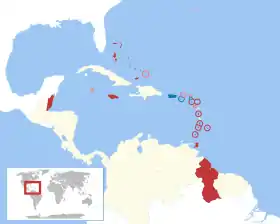Commonwealth Caribbean
The Commonwealth Caribbean is the region of the Caribbean with English-speaking nations and territories, which once constituted the Caribbean portion of the British Empire and are now part of the Commonwealth of Nations. The term includes many independent island nations, British Overseas Territories and some mainland nations. It is also known as the English-speaking Caribbean, Anglophone Caribbean or Anglo-Caribbean. The term is now used in preference over the older term British West Indies, which was used to describe the British colonies in the West Indies (especially the islands, so often excluding Belize and Guyana) during decolonisation and following independence from the United Kingdom. Anglo-Caribbean and British Commonwealth Caribbean also became preferred replacement terms to British West Indies.[1]
 Map of the Commonwealth Caribbean
Independent Nations
British Overseas Territories
Other English-speaking Territories
Other Caribbean Nations |
Nations and territories
The Commonwealth Caribbean consists of nations and territories, which include Caribbean islands or parts of the mainland surrounding the Caribbean Sea of North and South Americas.
Independent island nations
There are 10 independent island nations within the Commonwealth Caribbean:
| Sovereign state | Notes |
|---|---|
Independent mainland nations
There are two independent "mainland Caribbean" nations:
| Sovereign state | Notes |
|---|---|
British Overseas Territories
The term may also be applied to British Overseas Territories (BOTs) in the Caribbean, as they are also English-speaking and the United Kingdom is a member of the Commonwealth. However, other terms may also be used to specifically refer to these territories, such as "British overseas territories in the Caribbean",[2] "British Caribbean territories"[3] or the older term "British West Indies". There are 6 territories which are sometimes described as Commonwealth Caribbean:
| British Overseas Territory | Notes |
|---|---|
| Bermuda is sometimes not considered a part of the Caribbean, due to its geographic location in the North Atlantic Ocean and not the Caribbean sea. | |
U.S. Virgin Islands and Puerto Rico
The United States Virgin Islands is another English-speaking territory in the Caribbean, and Puerto Rico has English as an official language (Spanish is its working language however), but they're part of the United States, which isn't part of the Commonwealth.
Sint Maarten
Sint Maarten a constituent country of the Kingdom of the Netherlands, is also a majority English-speaking country in the Caribbean. However, as with the Kingdom of the Netherlands, it isn't a part of the Commonwealth. English is the day-to-day administrative language and language of communication in Sint Maarten, and the first language of the majority (67.5%) of the population.
West Indies Federation
Between 1958 and 1962, there was a short-lived federation between several English-speaking Caribbean countries, called the West Indies Federation, which consisted of all the island nations (except the Bahamas), and the territories (excluding Bermuda and British Virgin Islands). British Guiana (Guyana) and British Honduras (Belize) held observer status within the federation.

The Commonwealth Caribbean makes up a composite cricket team. The West Indies cricket team also includes Guyana, as another former British colony. Bermuda, the U.S. and British Virgin Islands, and the Dutch Caribbean also participate in Anglophone Caribbean-related sports activities such as Twenty20 cricket.
Caribbean Community
The English-speaking parts of the Caribbean established the Caribbean Community (CARICOM) in 1973, and it currently includes all the independent English-speaking island countries plus Belize, Guyana and Montserrat, as well as all other British Caribbean territories and Bermuda as associate members. English was its sole official language until 1995, following the addition of Dutch-speaking Suriname.
Informal Anglophone communities in Central America
In addition to these formally recognised countries, there are substantial communities of Commonwealth Caribbean origin along the Atlantic or Caribbean coast of Central America, as a part of the western Caribbean zone. These communities, which began forming in the seventeenth century, include areas of Nicaragua and Honduras that made up the Miskito Kingdom (which was under British protection after 1740), the Garifuna community (which was deported to the coast in 1797 and took up English as its language), the Archipelago of San Andrés, Providencia and Santa Catalina (Colombia), and the many and numerous Anglophone Caribbean people who were brought to Central America by the canal companies (the French and American Panama Canal efforts), railroad companies, and particularly the fruit companies, such as United Fruit after the 1870s and particularly in the first decades of the twentieth century. Many have never fully integrated into the otherwise Spanish-speaking communities in which they reside, such as the Caracoles of Honduras.
See also
- Anglo-America
- British Empire
- British North America
- British West Indies
- Caribbean Community
- Caribbean English
- English-speaking world
- Languages of the Caribbean
- West Indies cricket team
- West Indies Federation
Other parts of the Caribbean
Notes
- Staff writer (1989). "The Commonwealth Caribbean". Library of Congress, USA. Retrieved 31 August 2010.
- Tossini, J. Vitor (6 October 2017). "A Guide to British Overseas Territories in the Caribbean". Retrieved 9 February 2020.
- "British Caribbean Territories (WMO Territory)". World Meteorological Organization.
Further reading
- Mawby, Spencer. Ordering Independence: The End of Empire in the Anglophone Caribbean, 1947–69 (Springer, 2012).
- U.S. Library of Congress - The Commonwealth Caribbean